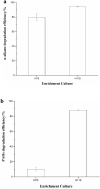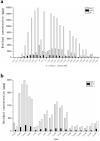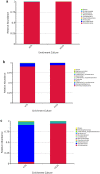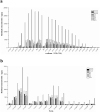Reconstruction and evaluation of oil-degrading consortia isolated from sediments of hydrothermal vents in the South Mid-Atlantic Ridge
- PMID: 33446871
- PMCID: PMC7809451
- DOI: 10.1038/s41598-021-80991-5
Reconstruction and evaluation of oil-degrading consortia isolated from sediments of hydrothermal vents in the South Mid-Atlantic Ridge
Abstract
In this study, sediments were collected from two different sites in the deep-sea hydrothermal region of the South Atlantic Ocean. Two microbial enrichment cultures (H7S and H11S), which were enriched from the sediments collected at two sample sites, could effectively degrade petroleum hydrocarbons. The bacterial diversity was analyzed by high-throughput sequencing method. The petroleum degradation ability were evaluated by gas chromatography-mass spectrometry and gravimetric analysis. We found that the dominant oil-degrading bacteria of enrichment cultures from the deep-sea hydrothermal area belonged to the genera Pseudomonas, Nitratireductor, Acinetobacter, and Brevundimonas. After a 14-day degradation experiment, the enrichment culture H11S, which was obtained near a hydrothermal vent, exhibited a higher degradation efficiency for alkanes (95%) and polycyclic aromatic hydrocarbons (88%) than the enrichment culture H7S. Interestingly, pristane and phytane as biomarkers were degraded up to 90% and 91% respectively by the enrichment culture H11S, and six culturable oil-degrading bacterial strains were isolated. Acinetobacter junii strain H11S-25, Nitratireductor sp. strain H11S-31 and Pseudomonas sp. strain H11S-28 were used at a density ratio of 95:4:1 to construct high-efficiency oil-degrading consortium H. After a three-day biodegradation experiment, consortium H showed high degradation efficiencies of 74.2% and 65.7% for total alkanes and PAHs, respectively. The degradation efficiency of biomarkers such as pristane and high-molecular-weight polycyclic aromatic hydrocarbons (such as CHR) reached 84.5% and 80.48%, respectively. The findings of this study indicate that the microorganisms in the deep-sea hydrothermal area are potential resources for degrading petroleum hydrocarbons. Consortium H, which was artificially constructed, showed a highly efficient oil-degrading capacity and has significant application prospects in oil pollution bioremediation.
Conflict of interest statement
The authors declare no competing interests.
Figures






Similar articles
-
Biodiversity and oil degradation capacity of oil-degrading bacteria isolated from deep-sea hydrothermal sediments of the South Mid-Atlantic Ridge.Mar Pollut Bull. 2021 Oct;171:112770. doi: 10.1016/j.marpolbul.2021.112770. Epub 2021 Sep 4. Mar Pollut Bull. 2021. PMID: 34492563
-
Biodiversity and degradation potential of oil-degrading bacteria isolated from deep-sea sediments of South Mid-Atlantic Ridge.Mar Pollut Bull. 2015 Aug 15;97(1-2):373-380. doi: 10.1016/j.marpolbul.2015.05.065. Epub 2015 Jun 12. Mar Pollut Bull. 2015. PMID: 26077158
-
Diversity and Hydrocarbon-Degrading Potential of Deep-Sea Microbial Community from the Mid-Atlantic Ridge, South of the Azores (North Atlantic Ocean).Microorganisms. 2021 Nov 19;9(11):2389. doi: 10.3390/microorganisms9112389. Microorganisms. 2021. PMID: 34835516 Free PMC article.
-
Biodiversity and degradation potential of oil-degrading bacteria isolated from sediments of hydrothermal and non-hydrothermal areas of the Southwest Mid-Indian Ocean Ridge.Environ Sci Pollut Res Int. 2022 Apr;29(18):26821-26834. doi: 10.1007/s11356-021-17826-3. Epub 2021 Dec 2. Environ Sci Pollut Res Int. 2022. PMID: 34854009
-
Effect of natural microbiome and culturable biosurfactants-producing bacterial consortia of freshwater lake on petroleum-hydrocarbon degradation.Sci Total Environ. 2021 Jan 10;751:141720. doi: 10.1016/j.scitotenv.2020.141720. Epub 2020 Aug 18. Sci Total Environ. 2021. PMID: 32882554
Cited by
-
Structures and diversities of bacterial communities in oil-contaminated soil at shale gas well site assessed by high-throughput sequencing.Environ Sci Pollut Res Int. 2024 Feb;31(7):10766-10784. doi: 10.1007/s11356-023-31344-4. Epub 2024 Jan 11. Environ Sci Pollut Res Int. 2024. PMID: 38200199
-
Crude oil degrading efficiency of formulated consortium of bacterial strains isolated from petroleum-contaminated sludge.3 Biotech. 2024 Oct;14(10):220. doi: 10.1007/s13205-024-04066-8. Epub 2024 Sep 5. 3 Biotech. 2024. PMID: 39247458
-
Microbial Consortia Are Needed to Degrade Soil Pollutants.Microorganisms. 2022 Jan 24;10(2):261. doi: 10.3390/microorganisms10020261. Microorganisms. 2022. PMID: 35208716 Free PMC article. Review.
-
Isolation and characterization of crude-oil-dependent bacteria from the coast of Ghana using oxford nanopore sequencing.Heliyon. 2023 Jan 25;9(2):e13075. doi: 10.1016/j.heliyon.2023.e13075. eCollection 2023 Feb. Heliyon. 2023. PMID: 36785818 Free PMC article.
-
Population dynamics and crude oil degrading ability of bacterial consortia of isolates from oil-contaminated sites in Nigeria.Int Microbiol. 2022 May;25(2):339-351. doi: 10.1007/s10123-021-00224-7. Epub 2021 Nov 22. Int Microbiol. 2022. PMID: 34806142
References
-
- Poddar K, Sarkar D, Sarkar A. Construction of potential bacterial consortia for efficient hydrocarbon degradation. Int. Biodeterior. Biodegrad. 2019;144:104770. doi: 10.1016/j.ibiod.2019.104770. - DOI
Publication types
LinkOut - more resources
Full Text Sources
Other Literature Sources

